Cockroaches, often regarded as the ultimate survivors of the insect world, have thrived on Earth for over 300 million years. These resilient creatures, scientifically known as Periplaneta americana (the American cockroach), belong to the phylum Arthropoda, a group characterized by jointed limbs and exoskeletons. Despite their infamous reputation as household pests, cockroaches are marvels of biological engineering, with intricate systems that allow them to adapt to diverse environments.
This comprehensive article explores the detailed anatomy of the cockroach, from its cellular structure to its complex organ systems, while weaving in unique insights and relatable examples to bring this fascinating creature to life.
Table of Contents
The Building Blocks: From Cells to Organ Systems
At the core of every living organism lies the cell, the fundamental unit of life. In cockroaches, as in all animals, cells group together to form tissues, which then combine to create organs. These organs work together in organ systems to perform essential functions like digestion, respiration, and reproduction. This hierarchical organization—cells to tissues to organs to organ systems—ensures that the cockroach operates as a highly efficient, self-sustaining organism.
Imagine a cockroach as a bustling city. The cells are like individual workers, each with a specific role. When these workers collaborate, they form departments (tissues) that handle particular tasks. These departments come together to create factories (organs), which, in turn, operate within larger networks (organ systems) to keep the city running smoothly. This analogy highlights the complexity and coordination within a cockroach’s body, a system refined by millions of years of evolution.
External Morphology: A Resilient Design
The cockroach’s external structure is a testament to its durability. Its body is divided into three main regions: the head, thorax, and abdomen, all encased in a tough exoskeleton made of chitin. This exoskeleton serves as both armor and a framework for muscle attachment, allowing the cockroach to scuttle swiftly across surfaces. The head houses sensory organs like compound eyes, which provide a wide field of vision, and antennae, which act as sensitive detectors for touch, smell, and even air currents.
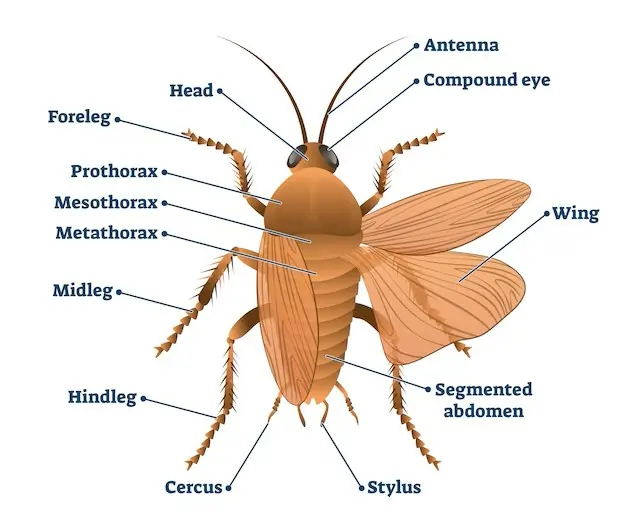
The thorax, the cockroach’s powerhouse, supports three pairs of legs designed for rapid movement and two pairs of wings in many species. While not all cockroaches fly, species like the American cockroach can glide short distances, aiding their escape from predators. The abdomen, elongated and segmented, contains vital organs and ends in cerci, sensory structures that detect vibrations, helping the cockroach evade threats. This external design is like a well-equipped survival suit, enabling cockroaches to thrive in environments ranging from tropical forests to urban kitchens.
The Alimentary Canal: A Digestive Powerhouse
The cockroach’s alimentary canal is a sophisticated system divided into three main sections: the foregut, midgut, and hindgut. Each section plays a unique role in processing food, ensuring the cockroach extracts maximum nutrients from its varied diet, which can include anything from plant matter to decaying organic material.
The journey of food begins at the mouth, where it enters the pharynx, a short passage leading to the esophagus. The esophagus opens into the crop, a sac-like structure that stores food temporarily, much like a pantry. From the crop, food moves to the gizzard, or proventriculus, which is equipped with six chitinous plates that act like teeth to grind food into smaller particles. This grinding action is crucial for breaking down tough materials, similar to how a coffee grinder processes beans.
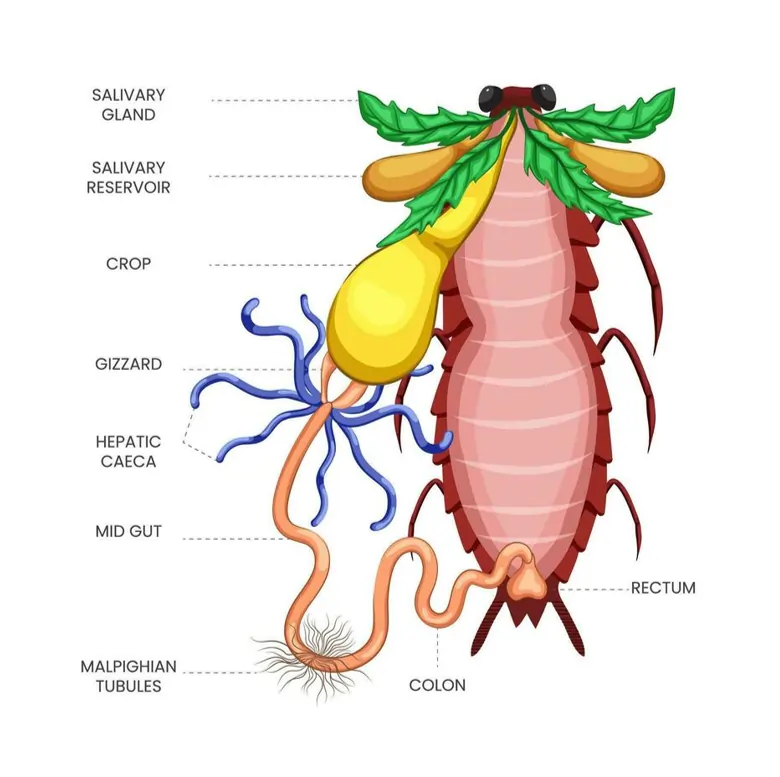
At the junction of the foregut and midgut, a ring of gastric caeca secretes digestive enzymes to break down nutrients further. The midgut is the primary site of digestion and absorption, where nutrients are extracted into the cockroach’s bloodstream. Finally, the hindgut, lined with Malpighian tubules (100-150 thin, yellow filaments), removes waste and excess water, funneling it toward the anus for excretion. This system is remarkably efficient, allowing cockroaches to survive on sparse or low-quality food sources.
| Section of the Alimentary Canal | Key Structures | Function |
|---|---|---|
| Foregut | Mouth, Pharynx, Esophagus, Crop, Gizzard | Ingestion, storage, and grinding of food |
| Midgut | Gastric Caeca | Digestion and nutrient absorption |
| Hindgut | Malpighian Tubules, Anus | Waste removal and excretion |
Blood Vascular System: An Open Circulation
Unlike humans, cockroaches have an open blood vascular system, meaning their blood, or hemolymph, does not flow through enclosed veins but freely bathes the organs in a cavity called the hemocoel. The hemolymph, composed of colorless plasma and hemocytes, carries nutrients and waste but does not transport oxygen, a role reserved for the respiratory system.
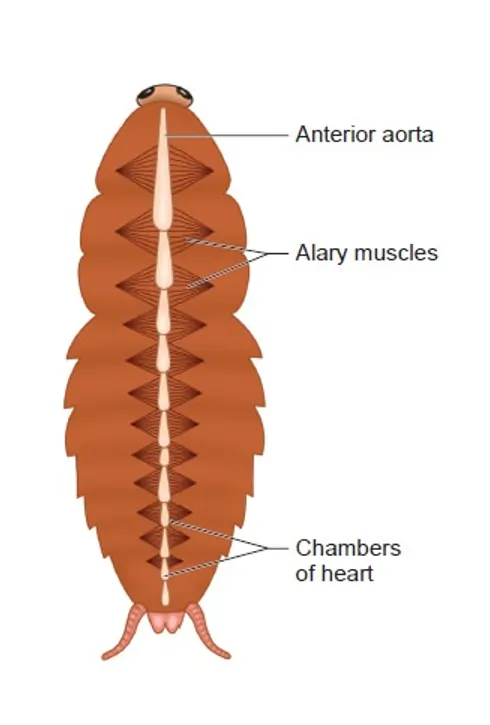
At the center of this system is the heart, a long, tubular organ with muscular walls and multiple chambers. Positioned mid-dorsally in the thorax and abdomen, the heart pumps hemolymph forward, circulating it through the hemocoel. Think of the heart as a simple water pump, pushing fluid through an open system rather than a closed network of pipes. This open circulation is less efficient than a closed system but suits the cockroach’s low-energy lifestyle, allowing it to survive in harsh conditions with minimal resources.
Respiratory System: Breathing Through Tubes
The cockroach’s respiratory system is a network of tracheae, tiny tubes that deliver oxygen directly to tissues. These tubes open to the outside through 10 pairs of spiracles, small holes along the body’s lateral sides. Each spiracle is controlled by a sphincter, which regulates airflow to prevent water loss or entry of debris. Oxygen enters the tracheae, diffuses through finer branches called tracheoles, and reaches individual cells, while carbon dioxide exits the same way.
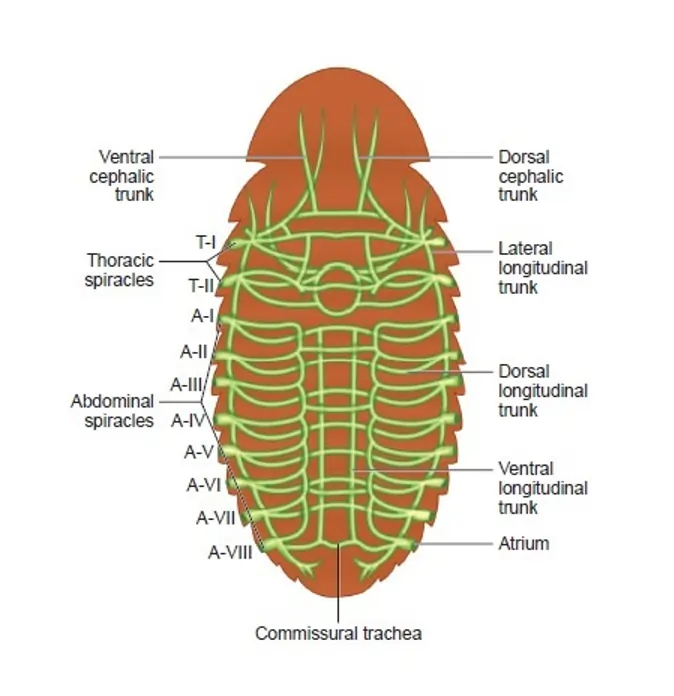
This system is like a natural ventilation network, delivering air directly to where it’s needed without relying on blood transport. It’s highly efficient for an insect’s small size, allowing cockroaches to sustain rapid movements and survive in low-oxygen environments, such as under debris or in tight crevices.
Nervous System: A Decentralized Control Center
The cockroach’s nervous system is a marvel of decentralized control, consisting of paired ganglia (nerve clusters) arranged segmentally across the body. Three ganglia in the thorax and six in the abdomen coordinate local functions, while the supra-oesophageal ganglion in the head, often called the brain, oversees sensory processing. However, the brain is not the sole control center; much of the nervous system is distributed ventrally, allowing the cockroach to function even if its head is damaged.
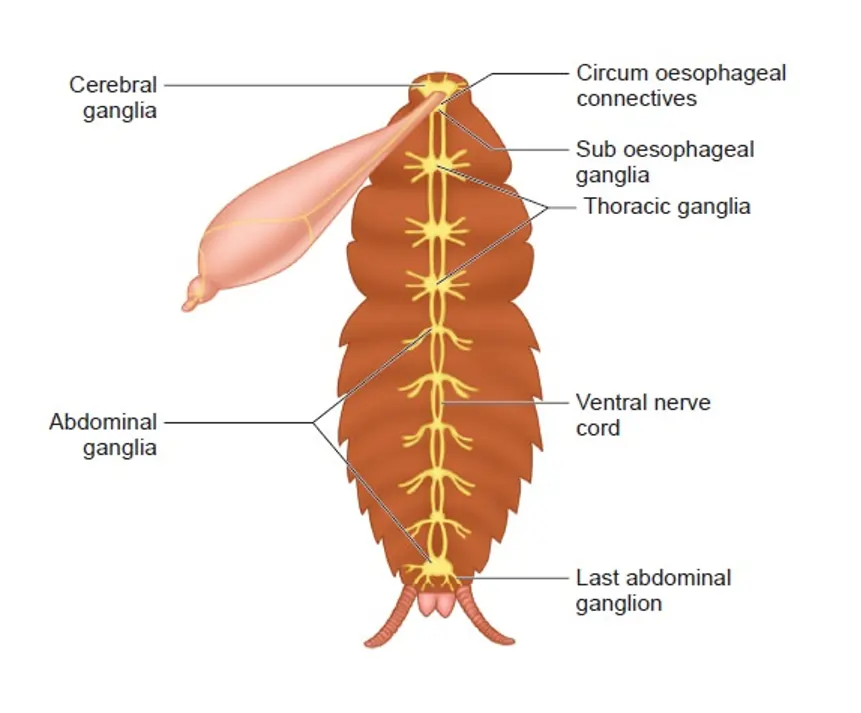
Sensory organs like antennae, compound eyes, maxillary palps, labial palps, and cerci feed information to the nervous system. For example, the antennae detect chemical cues, much like a dog’s nose, while the cerci sense vibrations, acting as an early warning system. This distributed nervous system enables lightning-fast reflexes, explaining why cockroaches can dart away the moment a light is turned on.
| Nervous System Component | Location | Function |
|---|---|---|
| Supra-oesophageal Ganglion | Head | Controls antennae, compound eyes |
| Thoracic Ganglia | Thorax (3) | Coordinates leg and wing movements |
| Abdominal Ganglia | Abdomen (6) | Manages abdominal functions |
| Sensory Organs | Various | Detects environmental stimuli |
Excretory System: Efficient Waste Management
The cockroach’s excretory system relies on the Malpighian tubules, slender structures at the midgut-hindgut junction. These tubules, lined with glandular and ciliated cells, absorb nitrogenous waste from the hemolymph and convert it into uric acid, which is excreted through the hindgut. This process, known as uricotelism, minimizes water loss, making cockroaches well-suited to dry environments.
Picture the Malpighian tubules as tiny filters in a water treatment plant, sifting out waste while conserving precious resources. This efficiency allows cockroaches to thrive in arid conditions, contributing to their global distribution.
Reproductive System: Ensuring Survival
Cockroaches have a well-developed reproductive system, with distinct differences between males and females. In males, a pair of testes in the 4th to 6th abdominal segments produces sperm, which is stored in seminal vesicles and delivered via the male gonapophysis, a chitinous structure. An accessory gland in the 6th and 7th segments secretes a substance that forms a protective casing for sperm transfer.
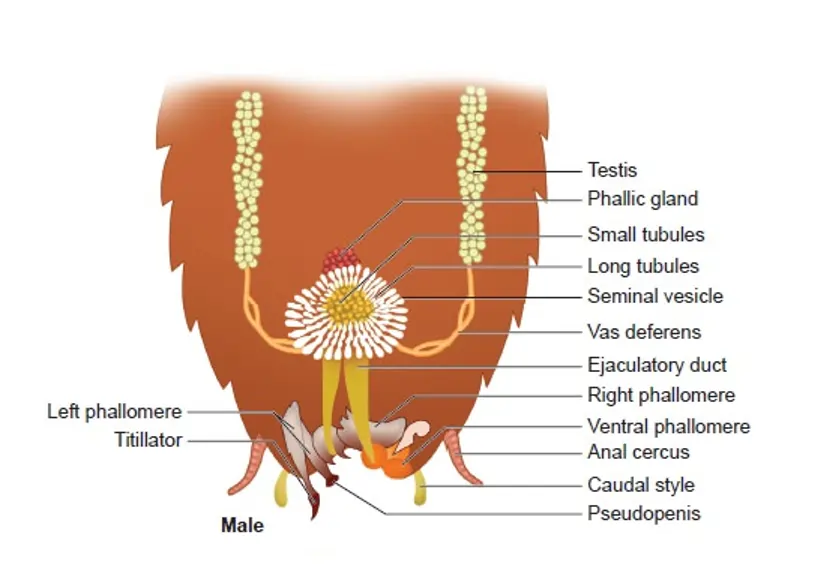
Females possess two large ovaries, each composed of eight ovarian tubules that produce eggs. These eggs are encased in a protective structure called an ootheca, which the female deposits in a safe location. Each ootheca contains 14 to 16 eggs, and a female can produce 9 to 10 oothecae in her lifetime, ensuring a high reproductive output. This prolific reproduction is like a factory assembly line, churning out new generations to maintain the species’ survival.
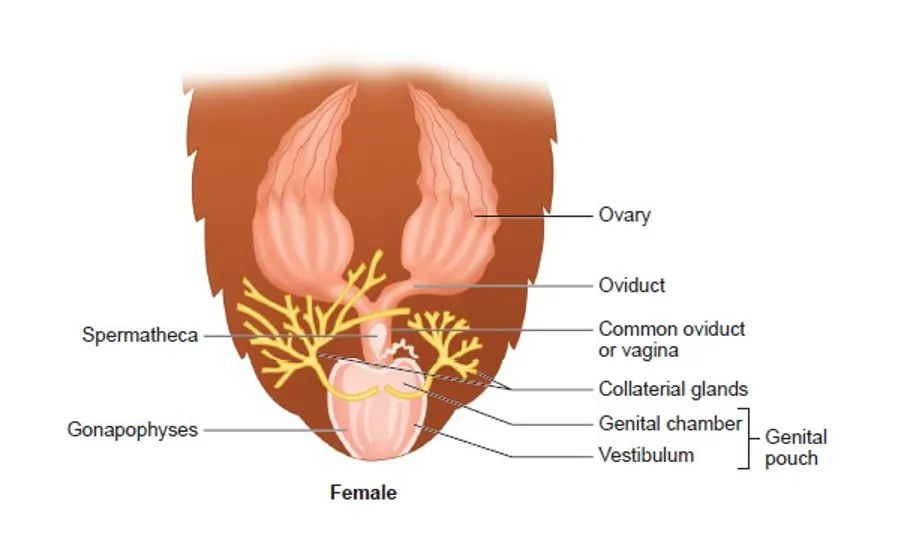
Adaptations and Survival: Why Cockroaches Thrive
Beyond their anatomical features, cockroaches possess remarkable adaptations that explain their resilience. Their exoskeleton protects against physical damage and desiccation, while their omnivorous diet allows them to feed on nearly anything, from crumbs to glue. Their nocturnal behavior and fast reflexes, driven by the nervous system, help them avoid predators. Additionally, their ability to survive without food for weeks and even regenerate lost limbs underscores their evolutionary success.
For example, a cockroach can survive decapitation for days because its nervous system is decentralized, and it breathes through spiracles rather than a mouth. This resilience has made cockroaches a subject of study in fields like robotics, where engineers mimic their agility and durability to design advanced machines.
Ecological and Scientific Significance
Cockroaches play a vital role in ecosystems as decomposers, breaking down organic matter and recycling nutrients. In forests, they contribute to soil health by consuming decaying plant material. Scientifically, their simple yet effective anatomy makes them ideal models for studying insect physiology and neurobiology. Their ability to develop antibiotic resistance is also under investigation, as it could inspire new medical treatments.
However, cockroaches are also vectors for pathogens, carrying bacteria like Allora and Salmonella on their bodies. This dual nature—as both ecological contributors and household pests—highlights their complex role in the world.
Conclusion: A Creature of Wonder
Far from being mere pests, cockroaches are biological masterpieces, with systems honed by millions of years of evolution. Their alimentary canal efficiently processes diverse foods, their open blood vascular system supports a low-energy lifestyle, and their tracheal respiration ensures oxygen delivery without blood. The nervous system enables rapid responses, the excretory system conserves water, and the reproductive system ensures their survival. By understanding their anatomy, we gain a deeper appreciation for their resilience and adaptability, qualities that have allowed them to outlast countless species.
Next time you spot a cockroach scurrying across the floor, pause to consider its intricate design—a testament to nature’s ingenuity. While they may not win our affection, cockroaches deserve our respect for their remarkable survival skills.
Related Articles
- Morphology of Cockroaches: A Deep Dive into Their Structural Marvels
- The Cockroach Respiratory System: A Masterpiece of Nature’s Engineering
- The Blood Vascular System of Cockroaches: A Detailed Exploration
- The Cockroach’s Nervous System: Nature’s Blueprint for Resilience and Reflex
- The Reproductive System of Cockroaches: Nature’s Resilient Reproducers
- The Cockroach’s Alimentary Canal: A Detailed Exploration
Also, Read These Articles in Detail
- Phylum Annelida: Characteristics and Its Classification with Detailed Exploration
- Anatomy of Earthworms: A Comprehensive Guide to Nature’s Unsung Heroes
- The Morphology of Earthworms: A Detailed Exploration of Structure and Function
- The Digestive System of Earthworms: Nature’s Soil Engineers
- The Earthworm’s Respiratory, Circulatory, and Nervous Systems: A Detailed Analysis
- The Earthworm’s Nervous System: A Comprehensive Exploration
- The Respiratory System of Earthworms: A Marvel of Natural Adaptation
- The Earthworm’s Closed Circulatory System: A Comprehensive Exploration
- Understanding the Excretory System of Earthworms: A Comprehensive Exploration
- The Reproductive System of Earthworms: A Deep Dive into Nature’s Hermaphrodites
- The Earthworm’s Life Cycle and Its Ecological Importance in Sustainable Agriculture
- Cells, Tissues, Organs, and Organ Systems in Animals and Plants
- Connective Tissue: The Essential Framework of the Body
- Epithelial Tissue: The Body’s Protective and Functional Shield
- Structural Organization in Animals: A Comprehensive Exploration of Cellular and Organismic Complexity
- Structure and Unique Biology of Frogs: A Comprehensive Exploration
Frequently Asked Questions (FAQs)
FAQ 1: What is the basic structure of a cockroach’s body?
The body of a cockroach is a marvel of natural engineering, designed for survival and adaptability. It belongs to the phylum Arthropoda, characterized by a segmented body and a tough exoskeleton made of chitin. The cockroach’s body is divided into three main regions: the head, thorax, and abdomen. Each region serves distinct functions, from sensory processing to movement and organ housing. This structure has allowed cockroaches to thrive for over 300 million years, making them one of the oldest surviving insect groups.
The head contains critical sensory organs like compound eyes, which offer a wide field of vision, and antennae, which detect smells, touch, and air movements. The thorax is the powerhouse, supporting three pairs of legs for swift movement and, in some species, wings for gliding. The abdomen, long and segmented, houses vital organs and ends in cerci, sensory structures that detect vibrations to help evade predators. This segmented design is like a well-organized machine, with each part contributing to the cockroach’s resilience and ability to navigate diverse environments, from forests to urban homes.
FAQ 2: How does the cockroach’s alimentary canal function?
The alimentary canal of a cockroach is a highly efficient system that processes a wide variety of foods, reflecting its omnivorous nature. It is divided into three main parts: the foregut, midgut, and hindgut, each playing a unique role in digestion. The process begins at the mouth, where food enters and passes through the pharynx and esophagus into the crop, a storage sac that acts like a temporary pantry. From there, food moves to the gizzard, equipped with six chitinous plates that grind food into smaller particles, much like a kitchen blender.
The midgut is where digestion and nutrient absorption occur, aided by gastric caeca, which secrete digestive enzymes to break down carbohydrates, proteins, and fats. At the junction of the midgut and hindgut, Malpighian tubules remove waste from the hemolymph, channeling it to the hindgut for excretion through the anus. This system is remarkably efficient, allowing cockroaches to extract nutrients from diverse sources, such as decaying matter or food scraps, ensuring their survival in challenging environments.
FAQ 3: What is unique about the cockroach’s blood vascular system?
Unlike humans, cockroaches have an open blood vascular system, meaning their blood, called hemolymph, does not flow through enclosed veins but circulates freely in a cavity called the hemocoel. The hemolymph, made up of colorless plasma and hemocytes, bathes the internal organs directly, carrying nutrients and waste but not oxygen. This open system is less complex than a closed circulatory system, yet it suits the cockroach’s low-energy lifestyle perfectly.
The heart of a cockroach is a long, tubular organ with muscular walls and multiple chambers, located mid-dorsally in the thorax and abdomen. It pumps hemolymph forward, circulating it through the hemocoel to nourish organs. Think of it as a simple pump pushing water through an open tank rather than a network of pipes. This system allows cockroaches to conserve energy, contributing to their ability to survive in harsh conditions with limited resources, such as during food scarcity.
FAQ 4: How do cockroaches breathe?
Cockroaches breathe through a respiratory system composed of a network of tubes called tracheae, which deliver oxygen directly to tissues without relying on blood. These tubes open to the outside through 10 pairs of spiracles, small holes along the sides of the body. Each spiracle is controlled by a sphincter, which regulates airflow to prevent water loss or debris entry. Oxygen enters the tracheae, travels through finer branches called tracheoles, and reaches individual cells, while carbon dioxide exits the same way.
This system is like a natural ventilation network, ensuring efficient oxygen delivery to support the cockroach’s active lifestyle. It allows them to thrive in low-oxygen environments, such as under debris or in tight spaces. For example, when a cockroach scurries across a kitchen floor, its tracheal system ensures its muscles receive oxygen quickly, enabling rapid movement to escape threats.
FAQ 5: What is the structure of the cockroach’s nervous system?
The nervous system of a cockroach is a decentralized network, making it highly efficient and resilient. It consists of paired ganglia, or nerve clusters, arranged segmentally across the body. There are three ganglia in the thorax and six in the abdomen, each controlling local functions like movement or organ activity. The supra-oesophageal ganglion, located in the head and often called the brain, processes sensory information from the antennae and compound eyes.
Unlike mammals, where the brain is the central control hub, a cockroach’s nervous system is spread throughout its body, with much of it located ventrally. This decentralization allows cockroaches to react quickly to stimuli, such as fleeing from danger. Sensory organs like maxillary palps, labial palps, and cerci enhance their ability to detect environmental changes, making them masters of survival. For instance, the cerci can sense vibrations from an approaching foot, triggering an instant escape response.
FAQ 6: How does the cockroach’s excretory system work?
The excretory system of a cockroach is designed for efficiency, particularly in conserving water, which is crucial for survival in dry environments. The primary excretory organs are the Malpighian tubules, 100-150 thin, yellow filaments located at the junction of the midgut and hindgut. These tubules, lined with glandular and ciliated cells, absorb nitrogenous waste from the hemolymph and convert it into uric acid, which is then passed to the hindgut for excretion through the anus.
This process, known as uricotelism, minimizes water loss, making cockroaches well-adapted to arid conditions. Imagine the Malpighian tubules as tiny water treatment filters, removing waste while preserving resources. This efficiency allows cockroaches to thrive in diverse habitats, from deserts to urban settings, where water may be scarce, contributing to their widespread distribution.
FAQ 7: How do cockroaches reproduce?
Cockroaches have a well-developed reproductive system that ensures their prolific survival. In males, a pair of testes in the 4th to 6th abdominal segments produces sperm, which is stored in seminal vesicles and transferred via the male gonapophysis, a chitinous structure. An accessory gland in the 6th and 7th segments secretes a substance that forms a protective casing for sperm during mating, ensuring successful fertilization.
Females have two large ovaries, each made up of eight ovarian tubules that produce eggs. These eggs are encased in a protective structure called an ootheca, which the female deposits in a safe location. Each ootheca contains 14 to 16 eggs, and a female can produce 9 to 10 oothecae in her lifetime, leading to a high reproductive output. This system is like a highly efficient production line, ensuring that cockroaches can rapidly repopulate, even in challenging environments.
FAQ 8: Why are cockroaches so resilient?
Cockroaches are renowned for their resilience, thanks to a combination of anatomical and behavioral adaptations. Their exoskeleton, made of chitin, acts as a protective shield against physical damage and dehydration. Their omnivorous diet allows them to feed on almost anything, from food scraps to organic debris, ensuring survival trades like sustainability in scarce conditions. Their decentralized nervous system enables rapid reflexes and survival even after severe injury, such as decapitation.
Additionally, cockroaches can survive without food for weeks and regenerate lost limbs. Their nocturnal behavior helps them avoid predators, and their tracheal respiratory system allows them to thrive in low-oxygen environments. For example, a cockroach can live for days without its head because it breathes through spiracles and has a distributed nervous system, making it a true survival expert in harsh conditions.
FAQ 9: What role do cockroaches play in ecosystems?
Cockroaches are often viewed as pests, but they play a significant role as decomposers in ecosystems. They break down decaying organic matter, such as leaves, wood, and dead animals, recycling nutrients back into the soil. This process supports soil health and promotes plant growth, making cockroaches vital contributors to natural ecosystems, particularly in forests and grasslands.
However, their role in human environments is less positive, as they can carry pathogens like Salmonella on their bodies, posing health risks. Their ability to consume a wide range of materials also makes them a challenge in urban settings, where they invade homes and contaminate food. Understanding their ecological importance alongside their pest status highlights the complex balance of their existence in nature.
FAQ 10: Why are cockroaches studied in science?
Cockroaches are valuable subjects in scientific research due to their simple yet effective anatomy and remarkable survival traits. Their nervous system, with its decentralized ganglia, is studied to understand neural processing and reflexes, offering insights into robotics and artificial intelligence. For example, engineers mimic cockroach agility to design robots for search-and-rescue missions in challenging terrains.
Additionally, cockroaches’ ability to develop antibiotic resistance is under investigation, as it could inspire new medical treatments to combat resistant bacteria. Their reproductive system and rapid breeding provide models for studying population dynamics, while their resilience in extreme conditions offers clues for developing durable materials. Cockroaches, despite their unpopularity, are a treasure trove of biological insights, contributing to advancements in science and technology.
FAQ 11: How does the cockroach’s exoskeleton contribute to its survival?
The exoskeleton of a cockroach, made of a tough material called chitin, is a key factor in its remarkable ability to survive in diverse environments. This hard outer layer acts like a suit of armor, protecting the cockroach from physical damage, predators, and environmental hazards like dehydration. The exoskeleton covers the entire body, including the head, thorax, and abdomen, providing structural support and a surface for muscle attachment, which enables rapid movement.
Beyond protection, the exoskeleton helps cockroaches squeeze through tight spaces, a trait that makes them notorious for infiltrating homes. It also plays a role in water retention, crucial for surviving dry conditions. However, the exoskeleton is rigid, so cockroaches must molt periodically to grow, shedding the old layer and forming a new one. This adaptability, combined with the exoskeleton’s durability, allows cockroaches to thrive in environments ranging from tropical jungles to urban sewers, making them one of nature’s most resilient creatures.
FAQ 12: What are the sensory organs of a cockroach, and how do they function?
Cockroaches rely on a suite of sensory organs to navigate their environment and avoid threats. These include compound eyes, antennae, maxillary palps, labial palps, and cerci, each with a specialized role. The compound eyes, located on the head, provide a wide field of vision, allowing cockroaches to detect movement and light changes, which is critical for their nocturnal lifestyle. The antennae, long and flexible, act as multi-purpose sensors, picking up chemical cues, touch, and air currents, much like a sophisticated radar system.
The maxillary and labial palps, located near the mouth, help detect food and assess its quality, aiding in the cockroach’s omnivorous diet. The cerci, found at the abdomen’s end, are highly sensitive to vibrations, serving as an early warning system for approaching threats. For example, when you try to swat a cockroach, its cerci detect the air movement, triggering a lightning-fast escape. This combination of sensory organs makes cockroaches highly aware of their surroundings, contributing to their elusive nature.
FAQ 13: How does the cockroach’s digestive system adapt to its omnivorous diet?
The cockroach’s alimentary canal is uniquely adapted to handle its omnivorous diet, allowing it to consume everything from plant matter to decaying organic material. The system is divided into the foregut, midgut, and hindgut, each tailored to process a wide range of foods. The foregut includes the crop, which stores food like a temporary holding tank, and the gizzard, which uses chitinous plates to grind tough materials, such as fibrous plant tissue or hardened scraps, into digestible particles.
In the midgut, gastric caeca release enzymes that break down carbohydrates, proteins, and fats, enabling the cockroach to extract nutrients from diverse sources. The hindgut, with the help of Malpighian tubules, removes waste efficiently, ensuring the cockroach maximizes nutrient absorption. This flexibility allows cockroaches to survive in environments where food is scarce, such as in urban settings where they feed on crumbs, grease, or even glue, showcasing their incredible adaptability.
FAQ 14: Why is the cockroach’s nervous system considered decentralized?
The nervous system of a cockroach is described as decentralized because it is not reliant on a single control center, like a human brain. Instead, it consists of paired ganglia—nerve clusters—distributed across the body. There are three ganglia in the thorax and six in the abdomen, each managing local functions like leg movement or digestion. The supra-oesophageal ganglion in the head processes sensory input from organs like the antennae and compound eyes, but it’s not the sole decision-maker.
This decentralization allows cockroaches to remain functional even if part of their nervous system is damaged. For instance, a cockroach can continue moving and responding to stimuli even after losing its head, as the thoracic and abdominal ganglia take over. This setup is like a network of regional offices that can operate independently, ensuring rapid reflexes and survival in dangerous situations, such as escaping predators or human attempts to eliminate them.
FAQ 15: How do Malpighian tubules function in cockroach excretion?
The Malpighian tubules are the cornerstone of the cockroach’s excretory system, designed to remove waste while conserving water. Located at the junction of the midgut and hindgut, these 100-150 thin, yellow filaments act like tiny kidneys, filtering nitrogenous waste from the hemolymph. The tubules are lined with glandular and ciliated cells that absorb waste products and convert them into uric acid, a less toxic compound that requires minimal water for excretion.
This process, known as uricotelism, is highly efficient, allowing cockroaches to thrive in dry environments where water is scarce. The uric acid is passed to the hindgut and expelled through the anus, minimizing water loss. Think of the Malpighian tubules as a recycling plant that efficiently processes waste while preserving resources, a critical adaptation that supports the cockroach’s survival in diverse habitats, from arid regions to urban basements.
FAQ 16: What makes the cockroach’s respiratory system efficient?
The respiratory system of a cockroach is a model of efficiency, relying on a network of tracheae to deliver oxygen directly to tissues. These tubes connect to the outside through 10 pairs of spiracles, small openings along the body’s sides, controlled by sphincters that regulate airflow to prevent water loss or debris entry. Oxygen travels through the tracheae and finer tracheoles to reach cells, while carbon dioxide exits the same way, all through diffusion.
This direct delivery system eliminates the need for blood to transport oxygen, making it highly effective for an insect’s small size. It supports rapid movements, like when a cockroach dashes away from danger, and allows survival in low-oxygen environments, such as inside walls or under debris. The tracheal system’s simplicity and efficiency are like a well-designed ventilation network, ensuring every part of the cockroach’s body gets the oxygen it needs to function.
FAQ 17: How does the cockroach’s reproductive system ensure high population growth?
The reproductive system of a cockroach is built for high output, ensuring the species’ survival through rapid population growth. In males, testes in the 4th to 6th abdominal segments produce sperm, which is stored and transferred via the male gonapophysis, a chitinous structure, during mating. An accessory gland secretes a protective casing for sperm, increasing fertilization success. This system ensures that males can efficiently pass on genetic material.
Females have two ovaries, each with eight ovarian tubules that produce eggs. These eggs are packaged into an ootheca, a protective case containing 14 to 16 eggs, which the female deposits in a safe location. A single female can produce 9 to 10 oothecae in her lifetime, potentially yielding over 100 offspring. This high reproductive rate, combined with the ootheca’s durability, is like a factory producing resilient capsules, ensuring that cockroaches can quickly repopulate even after population declines.
FAQ 18: How do cockroaches detect and evade threats?
Cockroaches are masters of evasion, thanks to their highly sensitive sensory organs and nervous system. The cerci, located at the abdomen’s end, detect vibrations and air movements, acting as an early warning system. For example, when you approach a cockroach, the cerci sense the air displaced by your movement, triggering an immediate escape response. The compound eyes detect changes in light and motion, while the antennae pick up chemical cues and physical contact, enhancing environmental awareness.
The decentralized nervous system, with ganglia in the thorax and abdomen, allows for rapid reflexes without relying solely on the brain. This setup enables cockroaches to react in milliseconds, darting away from threats like predators or humans. Their ability to navigate obstacles and squeeze through tiny gaps, aided by their flexible exoskeleton, further enhances their evasion skills, making them notoriously difficult to catch.
FAQ 19: What adaptations allow cockroaches to survive in extreme conditions?
Cockroaches are equipped with a range of adaptations that enable them to endure extreme conditions. Their exoskeleton protects against physical damage and dehydration, while their uricotelic excretory system conserves water, allowing survival in dry environments. The tracheal respiratory system enables them to function in low-oxygen settings, such as inside walls or under debris, by delivering oxygen directly to tissues.
Their omnivorous diet allows them to feed on virtually anything, from food scraps to organic matter, ensuring survival during scarcity. Cockroaches can also go weeks without food and even survive decapitation for days due to their decentralized nervous system and spiracle-based breathing. Additionally, their ability to regenerate lost limbs and their nocturnal behavior help them avoid predators, making them incredibly resilient in environments ranging from deserts to urban kitchens.
FAQ 20: How do cockroaches contribute to scientific research?
Cockroaches are invaluable in scientific research due to their simple yet robust anatomy and remarkable survival traits. Their nervous system, with its decentralized ganglia, is studied to understand neural processing and reflexes, inspiring advancements in robotics. For instance, researchers mimic cockroach agility to design robots for navigating rough terrains in search-and-rescue missions. Their respiratory system provides insights into efficient oxygen delivery, relevant to biomedical engineering.
Cockroaches’ ability to develop antibiotic resistance is also a focus of study, as it could lead to new treatments for bacterial infections. Their reproductive system offers a model for studying population dynamics, while their resilience in extreme conditions informs research into durable materials. By examining cockroaches, scientists gain insights into biology, ecology, and technology, proving that these creatures are more than just pests—they’re a gateway to scientific discovery.
Acknowledgements
The creation of the article “The Anatomy of Cockroach: A Comprehensive Exploration” was made possible through the wealth of information provided by various reputable sources. These resources offered detailed insights into the biology, anatomy, and ecological significance of cockroaches, ensuring the article’s accuracy and depth. The Examsmeta.com website deeply expresses its gratitude to the following organizations and platforms for their valuable contributions to the research process. Their comprehensive data and scientific expertise were instrumental in shaping a thorough and engaging exploration of this resilient insect.
- Encyclopaedia Britannica: Provided foundational knowledge on cockroach taxonomy and evolutionary history.
- National Geographic: Offered insights into the ecological roles and behavioral adaptations of cockroaches.
- Smithsonian Institution: Contributed detailed information on insect anatomy and physiology.
- BBC Science Focus: Shared accessible explanations of cockroach survival mechanisms.
- Nature: Provided peer-reviewed studies on cockroach neurobiology and antibiotic resistance.
- Scientific American: Offered perspectives on cockroach resilience and scientific applications.
- Live Science: Contributed engaging details on cockroach sensory systems and locomotion.
- The Royal Society: Supplied in-depth research on insect respiratory systems.
- American Entomological Society: Provided expertise on arthropod morphology and reproduction.
- CSIRO: Offered information on insect ecology and environmental adaptations.
- Oxford Academic: Contributed scholarly articles on cockroach digestive systems.
- PLOS: Shared open-access research on insect excretory systems and uricotelism.
- ScienceDirect: Provided detailed studies on cockroach nervous system decentralization.
- PubMed: Supplied medical and biological research on cockroach-related pathogens.
- New Scientist: Offered innovative perspectives on cockroach applications in robotics and biomedicine.

